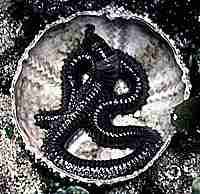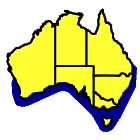|
|
Eunice Eunice aphroditois
Form:
 Eunice
is a long, multi-segmented, robust bodied predatory
worm and one of the largest polychaetes
in the world.
Eunice
is a long, multi-segmented, robust bodied predatory
worm and one of the largest polychaetes
in the world.
It has two eyes and five tentacles. Its unusual feeding structure, called a pharynx, or proboscis, turns inside out, like the finger of a glove, to capture prey. Sharp mandibles, at the pharynx end can give a nasty bite.
There are numerous body segments which look like joined-together rings. On the both sides of each ring is a pair of movement lobes called parapodia. Each parapodia is tipped with bundles of bristles, called setae or cirri.
"Para" means "like" and "podia" means "legs"..
Colour:
Overall colour is is dark purple-brown to red-brown, with a purple iridescence. There is a white ring around the fourth body segment.
Phylum: |
Annelidae |
Author: |
Quatrefages |
Family: |
Eunicidae |
Size: |
500 - 1000 mm |
Distribution:
 Eunice
species are widespread around the world. In Australia this form ranges
around southern shores from south-eastern Queensland to Geraldton in Western
Australia.
Eunice
species are widespread around the world. In Australia this form ranges
around southern shores from south-eastern Queensland to Geraldton in Western
Australia.
Habitat:
Eunice occurs under stones lying in sand or mud at low tide level, and below, on rocky shores.
References:
This species name is now in question. The common form in southern Australia is called Eunice aphroditois in most references, but Edgar is uncertain, and thinks it may be something else. Edgar is using the name Eunice tentaculata.
Bennett, I. (1987) W.J. Dakin's classic study: Australian Seashores. p. 190, Angus & Robertson, Sydney.
Davey, K. (1998) A Photographic Guide to Seashore Life of Australia. p. 37, New Holland, Sydney.
Edgar, G.J. (1997) Australian Marine Life: the plants and animals of temperate waters. p. 159, Reed Books, Kew.
Shepherd, S.A. & Thomas, I.M. (1982) Marine Invertebrates of Victoria, Pt. 1. p. 257, South Australian Government Printer, Adelaide.
Eunice
Bristle Worm
Galeolaria
Scale Worm
Peanut Worm
Home
Page
Taxonomy
Biogeography
Rocky Shores
Tidal Levels
Intertidal Zonation
Environmental Factors
Biological
Factors
Feeding Relationships
Activities
Glossary
References
 Life
on Australian Seashores
Life
on Australian Seashores
by Keith Davey (C) 2000
Learning Consultant
- Media
The University of Newcastle
email at australian_seashores@hotmail.com
Scientific Consultant: Phil
Colman
site created 01.01.98 : updated 01.04.2000
